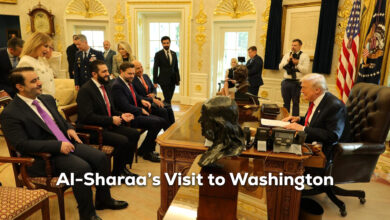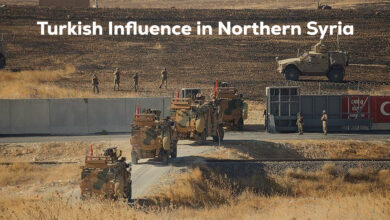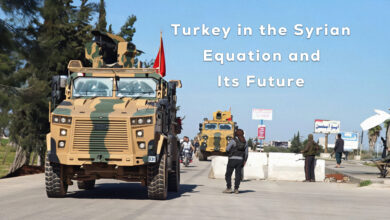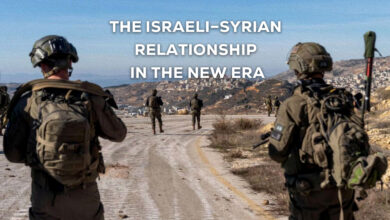Developments in Idlib and northern Aleppo in the areas of the National Army and Tahrir al-Sham and possible scenarios

Idlib and northern Aleppo are witnessing rapid developments between the so-called Syrian National Army (SNA) and Hay’at Tahrir al-Sham (HTS). These developments include changes in an attempt to impose influence and expand in the midst of new political and military balances. Many possible scenarios may occur as a result of protests erupting against the (HTS) amid anticipation of what these events will lead to in the future.
First: Areas of influence in northwest Syria
Undoubtedly, if we exclude the Syrian Democratic Forces (SDF) as a force in northeastern Syria, northwest Syria can be divided into two main military regions alongside the Syrian regime; one under the control of armed factions, and the other belonging to the (HTS).
1- Distribution of influence between the (SNA) and the (HTS):
While this division takes into account the geographic framework and the military distribution of these forces through Turkish military operations in Syria, it focuses on the aspect of influence of these forces and their political structures, in order to estimate their weight and military significance. Despite the fact that the positioning map since 2020 has witnessed a significant military and political stagnation, there have been no major changes in the map of control and influence, taking into account the level of competition and the attempts of each to impose control over the other’s areas.
– First Area:
The emergence of the armed opposition dates back to the beginning of the Syrian revolution in 2011, where the northern regions of Syria, like its south in Daraa and Homs, witnessed peaceful protests that eventually turned into armed movements against the Syrian regime. Despite the regime’s loss of those areas, the opposition failed to establish a unified military and political body to lead them. This shift in the geopolitical landscape led to the expansion or contraction of the opposition geographically, with the emergence of chaos, security breakdown, and the alignment of opposition leaders in favor of Turkey. Additionally, armed factions took advantage of the opportunity to seize wealth and personal privileges, leading to the emergence of extremist terrorist groups such as ISIS and HTS (formerly known as Jabhat al-Nusra).
Since 2016, Turkey has carried out a series of military operations in northern Syria as part of a specific strategy to implement the Milli Pact (Safe Zone Agreement). These operations aimed to enhance Turkish influence and expand its vital area in the region. Turkey relied on the so-called SNA, whether in Syria or beyond, to secure protection zones for it in areas known as de-escalation zones and to resettle some Syrian refugees in areas controlled by Turkey.
The armed factions in those areas include at least 40 military groups, and except for those active in Idlib, all factions have been organizationally affiliated since 2017 to 3 brigades within what is known as the “Syrian National Army.” This army comprises more than 20,000 fighters who are under the Ministry of Defense in the opposition government based in Turkey. The areas include villages and towns located north and west of Aleppo province, stretching between the city of Gire Sipi (Tel Abyad) to the east and the occupied Afrin to the west.
Practically, these armed factions (the national army) are not characterized by an ideological nature of a professionally trained army despite being distributed over wide areas, where they are distinguished by different inclinations, including regional, Islamic, tribal, and nationalist tendencies. However, one faction may include a number of these inclinations, but they all pledge allegiance to Turkey. This has raised concerns about Turkey’s regional ambitions, leading to political tensions with the United States and Russia, especially as it is part of a larger strategy for Turkey to enhance its position and presence as a military force in Syria.
– Second Area:
This region is under the control of HTS (formerly known as Jabhat al-Nusra) after two years of battles with the armed factions, leading to weakening their power and many of them moving to northern Aleppo at times, and at other times, their influence receding as government forces advance with Russian support.
HTS formed a unique structure in those areas, including an administrative and judicial system. This structure was marked by stark contradictions stemming from a conflict between an extremist jihadist identity and the reality of a repressive political presence through its monopolization of governance, without giving the local community, which believed it was the owner of the revolutionary movement, the necessary freedoms and acceptance of differing opinions. Instead, it imposed its extremist tendencies and singular vision. These methods led to deep internal conflicts reflecting the local community’s aspirations for freedom and democracy, but the reality is the opposite through the imposition of its ideological control.
The HTS faced criticism due to the restrictions it imposes on personal freedoms and the arbitrary practices it carries out on civilians or even its own members, leading to the arrest of leaders on charges of dealing with other parties. The HTS’s practices were not limited to imposing internal restrictions but also sought to expand at the expense of areas controlled by other factions. In 2023, the HTS entered the occupied city of Afrin, reached the border crossing of Al-Hamran, and planned to expand to the east of the Euphrates with the support of Turkey. However, these aspirations faced strong opposition from the United States, halting this expansion.
The Conflict between HTS and the SNA:
The relationship between HTS and the SNA was not going well, as their goals in Syria conflicted with each other despite both claiming to be fighting the Syrian regime. This relationship experienced a lot of tensions and sometimes fighting, especially since the SNA, which includes the “Free Men of the Levant Movement – Eastern Sector” and “Tawhid Brigade” along with groups in the “Nour al-Din al-Zenki Movement” in addition to “Division 50,” accused the “Shahba Legion” of loyalty to HTS. Meanwhile, there were four attempts by HTS to militarily penetrate northern Aleppo.
As for the HTS, they are seeking to achieve two goals: first, to strengthen their position in northern Syria by expanding their control and influence, as well as dominating the crossings, especially Al-Hamran crossings, in an attempt to control the economies of informal crossings to support financing and provide services to the residents of Idlib. They also aim to enhance the internal crisis within the SNA among the military components in Aleppo.
The second goal is to enhance their position in any future settlements, and to try to advance towards areas controlled by the SNA loyal to Turkey, to increase pressure on Turkey and hinder rapprochement between it and the Syrian regime. This step may lead to the removal of the “HTS” from the scene, sending a message that it must be part of any settlement in northern Syria, especially since it controls wide areas and has the ability to obstruct any future agreements.
Second: Developments in Idlib and north of Aleppo
Anti-HTS protests spread in several areas in Idlib and the western countryside of Aleppo, during which the protesters chanted slogans calling for the overthrow of the HTS’ leader, Abu Mohammad al-Julani, and demanding the release of the detainees.
1- Objectives of anti-HTS protests
Protests broke out against the HTS, specifically against the so-called “espionage”, against the backdrop of the arrest of hundreds of civil activists, prisoners of conscience, and others, amid fears of killing them, especially after torturing to death Abdulqader al-Hakim, known as Abu Ubaida Tal Hadiya, which sparked the discontent of the residents who took to the streets, specifically after the increase in tension from various factions within the HTS after it became clear that a number of detainees were tortured and other managed to escape, including former leaders. This is evident from the intensity of popular demands.
The protesters raised many slogans that fall within messages directed to reject the policies of the HTS in general, but the most prominent of them is the slogan they chanted demanding the overthrow of Abu Mohammad al-Julani and the cessation of the practices of his General Security Service against civilians, the release of detainees, and the disclosure of the forcibly disappeared. It also demanded the right to free expression and pointed to the absence of justice in the judicial system, the cessation of controlling trade and imposing high taxes on citizens. However, its organizers vowed to continue their movement until the demands were met, especially denouncing the policy of the HTS which they described as similar to the Syrian regime, its security branches, and its iron fist.
2- Factors influencing popular protests:
The comprehensiveness of the protests put pressure on the HTS not to clash with the protesters, and to a greater extent to put pressure to implement the demands immediately, as the protests were monitored in Idlib Governorate including the cities and towns of Idlib city, Binnish, Taftanaz, al-Foua, Sarmada, Kalli, Atma, Deir Hassan, Termanin, Ahsim, Kafr Takharim, Ariha and Jisr al-Shughur IDP camps. In Aleppo, the protests were held in al-Atareb, Darat Izza and al-Abzimo.
– The general nature of the demonstrations is popular protests that aspire to make reforms and changes that will rescue the region from the living and economic crises, not to mention the deteriorating economic situation, which is characterized by increasing unemployment and high poverty rates, especially with the leaders of the HTS’ control over the main economic sectors, especially fuel trade.
The goals of the protests are parallel to the feelings of marginalization on the part of the active figures, as the participation of former military and Sharia members was observed, or the marginalization of areas such as the city of al-Atareb, especially since activists had previously launched a campaign “No to marginalizing Atareb”, and the same applies relatively to the city of Dara Izza. Also, in terms of the role played by the distribution of activists, whether they are many or few, which explains the recurrence of demonstrations in the city of Idlib, and their failure, for example, in most areas of Jabal al-Zawiya due to the low population there.
Third: Future scenarios
It is not possible to understand what is going on in northwestern Syria whether by the SNA or the HTS in isolation from the map of political-military balances, locally or internationally. This map is linked to the extent of improvements and changes of the external appearance that they are working on with the aim of accepting these military entities in international circles to a greater degree to play a role in any possible political understandings regarding Syria for both military blocs. Although they have come close to each other at times through the formation of a military council in Idlib and the establishment of operations rooms to confront the military campaigns in the de-escalation zone, what separates them is much greater.
On the practical level, the so-called Syrian National Army (SNA), with the support of Turkey, is implementing a military plan in its areas with the aim of preventing and containing any incursion from the HTS in preparation for the possibility of transferring the experiment to areas controlled by the HTS in Idlib. The plan includes transferring a number of groups to the Military Police, expanding and developing the Border Guard forces, and converting some factions or part of them into Rapid Intervention Forces or Special Forces. This means ending the state of division that has been associated with it throughout the period of its emergence, and presenting it as an alternative as an army for the future Syria despite the humanitarian atrocities it has caused to civilians.
While the HTS seeks to go far into the areas of the SNA, especially for Turkey that believes that dealing with one Syrian entity – the HTS – that controls all the areas controlled by the opposition is easier and more efficient than dealing with multiple and smaller factions engaged in permanent competition taking into account that this idea is gaining more momentum after the HTS’ efforts to re-present and promote itself as a moderate force in addition to its attempt to bolster its funding sources by controlling the border crossings, especially the al-Hamran.
In the general context, the so-called SNA appears on the ground to be not yet qualified and equipped to be a single military body despite the Turkish support and role in sponsoring it with funds and military equipment, while the HTS is looking to get rid of its classification as a terrorist organization by transforming into a more moderate and pragmatic movement socially, politically, and ideologically, as well as through cooperation with Western countries in the war against terrorism. However, in the foreseeable reality, the HTS is facing popular protests against it, as we can identify possible scenarios for it that are related to the development of the protests, as the HTS will work to know who is with it and who is against it, and who it can rely on to curb the protests, to make it easier for it to influence the most affected people.




